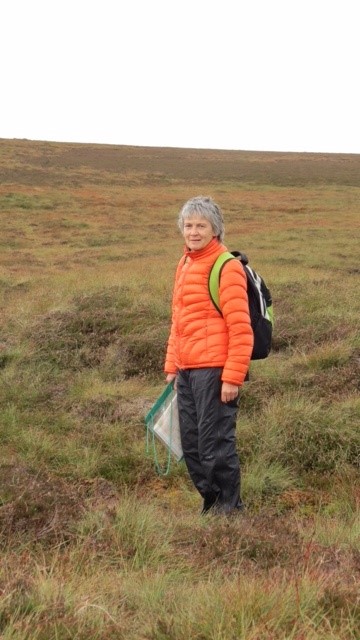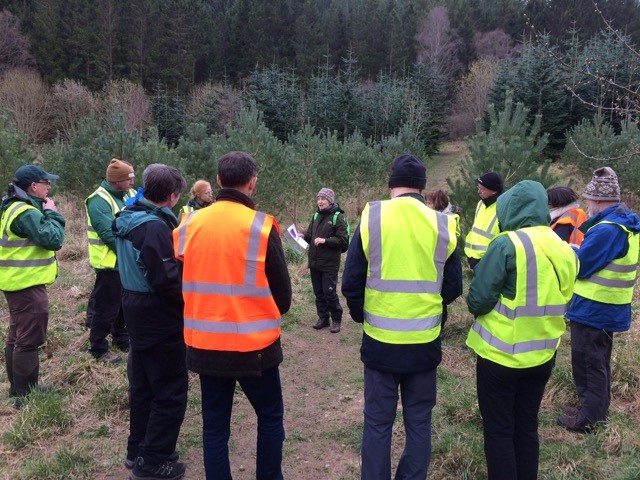Molecular approaches to support forest resilience
“Early influences have a profound effect on how our later lives develop,” says Dr Joan Cottrell. “Born to Scottish parents, I was fortunate to be raised in rural Carmarthenshire on the edge of the South Wales Coalfield. This is where I developed a close affinity with nature and the outdoors which has stayed with me ever since.
“I received my early education entirely through the medium of Welsh and went on to attend Gwendraeth Grammar School which is famous for producing many international rugby stand offs. The teachers there nurtured my interest in biology and the high standard of the botany ‘A’ level syllabus at the time laid a sound foundation by introducing me to the concepts of plant taxonomy, physiology and structural and developmental anatomy.
“I was unsure how I could convert an interest in botany into a career, so I elected to do an applied degree in Horticultural Botany at Reading University at the time when Professor Hugh Bunting was the charismatic head of department. This was followed by a Shell CASE studentship on cereal physiology at Edinburgh University’s Botany Department, where I experienced the agrochemical industry first hand with periods spent at Shell Laboratories in Sittingbourne in Kent. I continued in this field for a further four years in postdoctoral posts at the Botany Department.
“Later, I moved to the Scottish Agricultural College to work as a postdoc on the biochemistry of low-temperature sweetening in potatoes, an important problem in the crisp industry. This may seem a strange background for a career in forest genetics and conservation, but people often make a few false starts before they find their career niche. In retrospect, I think I may have lacked role models to guide me in my key early career choices. However, these years gave me a taste for research, a foundation in the research method and a broad experience across several fields of plant science which have served me well in later years.
Forest Research
“I started my first permanent job at Forest Research in 1991. Working on more conservation-orientated topics in the setting of an applied research organisation provided me with the role I had been searching for. I was initially employed to establish a molecular laboratory at the Northern Research Station in Roslin, Midlothian. Soon after I joined, PCR-based DNA methods began to be introduced which opened the door to many novel areas of study. I was very excited to participate in an EU-funded project which generated the first pan-European map of chloroplast DNA variation in oaks, which allowed the species’ postglacial colonisation routes to be traced. The map is very visual and has since been used widely to demonstrate the power of molecular markers.

“I led the Habitats, Species and Genes Science Group at Forest Research for over ten years, with the aim of harnessing molecular methods to tackle ecological questions. I worked with ecologists to promote the use of DNA metabarcoding in monitoring biodiversity and contributed to the genetic understanding of rare species such as black poplar, wood ant and twinflower.
Genetic Resources
“However, during that time the main focus of my research was to understand the distribution of neutral and adaptive genetic diversity in forest tree species. This is determined by founding material, geneflow and natural selection and an understanding of these processes has become highly relevant when policymakers struggle to develop sensible guidelines for making our woodlands resilient to climate change and the arrival of exotic pests and diseases.
“Through collaborations with the Centre for Ecology and Hydrology and the University of Edinburgh, we established a series of provenance trials and generated data to reveal the amount and drivers of differentiation in our native tree species. Building on this research, we have worked hard to raise awareness of the importance of forest genetic resources and their power to enable populations to adapt to climate change and pest and disease challenges.
“My long-standing membership of EUFORGEN, an international cooperation programme that promotes the conservation and sustainable use of forest genetic resources (FGR) in Europe has ensured that the UK is aware of, and participates in, initiatives for the conservation of FGR at a pan-European scale. A good example of this collaborative approach is the establishment of a network of Gene Conservation Units for forest tree species which aims to maintain and enhance the long-term evolutionary potential of tree populations across Europe.
“I have recently become Head of Forest Genetics at Forest Research which will bring me closer to colleagues working on tree breeding. This is not such a big change of direction, as FGR form the raw materials for all breeding work, and closer cooperation between the disciplines of FGR conservation and tree breeding is already resulting in exciting collaborations.

“There are several reasons why I enjoy my job. Firstly, though challenging in the breadth of topics I cover and the different aspects the work entails, it is satisfying to have a sense of purpose and to feel that my efforts are making a beneficial contribution to understanding and to forest policy. Secondly, one of the most rewarding aspects of my job is the supervision of PhD students. It has been a great pleasure to play some small part in guiding them through their early research experiences and to see them develop into scientists in their own right. Thirdly, the job has allowed me to visit some amazing woodlands both in Britain and abroad. Finally, it has been a privilege to work with talented collaborators and colleagues whose dedication to forestry and to conservation has made the last thirty years an interesting journey.”
Dr Joan Cottrell is Head of Forest Genetics at Forest Research. Find out more here.
This post is part of a series showcasing Scotland’s innovative, high-impact research supporting biodiversity conservation, in partnership with Scottish Government and NatureScot. Read the rest of the series here.
Further reading
Petit, R.A., et al. 2002. Identification of refugia and post-glacial colonisation routes of European white oaks based on chloroplast DNA and fossil pollen evidence. Forest Ecology and Management 156(1-3): 49—74. https://doi.org/10.1016/S0378-1127(01)00634-X
Petit, R.A., et al. 2002. Chloroplast DNA variation in European white oaks: Phylogeography and patterns of diversity based on data from over 2600 populations. Forest Ecology and Management 156(1-3): 5—26. https://doi.org/10.1016/S0378-1127(01)00645-4
Fady, B., et al. 2015. Forests and global change: what can genetics contribute to the major forest management and policy challenges of the twenty-first century? Regional Environmental Change 16: 927—939. https://doi.org/10.1007/s10113-015-0843-9
Bellamy, C., et al. 2018. Encouraging biodiversity at multiple scales in support of resilient woodlands. Forestry Commission Research Note: Ecosystem Services. https://www.forestresearch.gov.uk/publications/encouraging-biodiversity-at-multiple-scales-in-support-of-resilient-woodlands/
Ennos, R., et al. 2020. Species diversification – which species should we use? Quarterly Journal of Forestry 114(1): 33—41. https://www.forestresearch.gov.uk/publications/species-diversification-which-species-should-we-use/
Bellamy, C., et al. 2021. Can biodiversity help our woodlands in a changing climate? Forest Research Factsheet: Climate Change and Biodiversity. https://www.forestresearch.gov.uk/publications/factsheet-climate-change-and-biodiversity/
